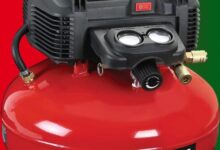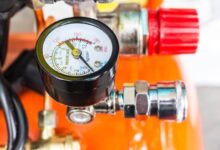DIY Painting Your Car: How To Paint A Car With A Small Air Compressor
Last Updated on July 27, 2022 by Thomas James
If you have a car that needs some paint, there are plenty of ways to do it. However, one way that is not often talked about is painting the car with an air compressor. It is not recommended that you paint your car with a compressor as it can create a lot of paint dust and require a lot of cleanups after. However, it is worth a shot if you have a specific car that you need to paint. This blog will show you how to paint a car with a small air compressor.
Automotive painting is a tricky process. Even if you do a great job of cleaning the car surfaces, there is still a chance that the paint will peel off later and turn an otherwise paint job into a disaster. Luckily, there are many ways to avoid automotive painting disasters, but the first step is always to paint protection.

Selecting the Most Appropriate Air Compressor for Painting a Car
When you are looking to buy an air compressor for automotive painting, there are many different things that you need to consider. Choosing the best spray-painting air compressor necessitates a systematic approach to both the pre-purchase and purchase processes. Here are the factors we believe are most important to consider when selecting an air compressor for painting:
Air Compressor Size
It is one of the most important factors to consider when purchasing an air compressor for automotive painting. Two types of air compressors are commonly used in the automotive industry: a two-stage compressor and a three-stage compressor.
A two-stage compressor consists of a small compressor and a large compressor. The small compressor is used to deliver the compressed air to the larger compressor, which is then used to deliver the compressed air to the spray gun. If you have a small car, you may want to consider a smaller air compressor. Smaller compressors are easier to handle and are less likely to cause damage to your car. However, if you have a larger car than a mid-size sedan, you may want to consider a larger compressor.
DIYers like portable air compressors. They are lighter, smaller, and more maneuverable than their stationary counterparts. Portables are typically small in size and come in various styles (e.g., pancake, hotdog, wheelbarrow shape).
PSI and CFM
The second most important factor to consider when purchasing an air compressor for automotive painting is the air pressure and the airflow rate. Air pressure and airflow rate are vital because they affect the paint spray and how much paint you can use. Air pressure and airflow rate are usually measured in PSI (pounds per square inch) and CFM (cubic feet per minute).
When it comes to air compressors, pounds per square inch (PSI) gets a lot of attention, and for a good reason. On the other hand, higher PSI ratings do not always translate into better performance in most applications. In fact, the compressor’s cubic feet per minute (CFM) rating is a more important metric for many applications.
Horsepower (HP)
Another specification to consider with PSI and CFM. With paint sprayers rated at 6 CPM and 30-40 PSI, a 1 to 2 HP motor is adequate for most DIY and non-industrial applications. 2 HP air compressors are now available in the mainstream retail market. You should be fine if your choice provides at least 8 CFM at 40 PSI.
Considerations for Operations
Because air compressors are motor-driven, they generate friction and heat while operating. It is especially true for oil-free compressors, which are increasingly popular among hobbyists and DIYers. To avoid compromising the quality of your paint job and safety, especially in a closed room, make sure the working area is well-ventilated.
Air Compressors: Oiled vs. Oilless
One of the most important factors to consider when purchasing an air compressor for automotive painting is whether the compressor is oiled or oilless.
Oiled air compressors are typically used for industrial applications. They are designed to run continuously for extended periods, and their lubrication systems are designed to protect the compressor from excessive wear. Oiled air compressors are also known as industrial air compressors.
Oilless air compressors are typically used for hobby and DIY applications.
Noise and Noise Control
When purchasing an air compressor for automotive painting, make sure the compressor is quiet. In fact, quiet is one of the most important specifications to consider.
When it comes to noise, an air compressor is most noticeable when it is running. To avoid disturbing your neighbors, purchase a quiet air compressor. There are soundless compressors, but they are quite expensive and out of reach for most individuals and businesses. Sound dampers (e.g., fiberglass insulation, mineral wool, packed fiber) can be installed in your workspace to block sound and prevent it from spreading outward.
Price and Purchasing Advice
There are a variety of air compressors available in the retail market. Before making a purchase, make sure you shop around to find the best deal. You can also use the internet to find the best air compressor for your needs. If you’re looking for a low-cost DIY project, pancake-shaped and portable air compressors might be the way to go. They are generally smaller, lighter, and allow for chaining, eliminating the need for a 220v outlet.
How To Paint A Car With A Small Air Compressor: Steps & Tips
You may be thinking that a small air compressor is not powerful enough to do a good job. Well, we will show you that it can do a great job if you follow the steps and tips that we have in this article. Following a few simple steps, you will be able to spray paint your car on your own using a small air compressor.
Safety Equipment
You must use safety equipment when using a small air compressor. If you don’t, you may get injured. For safety measurements, wear goggles, a respirator mask, and gloves.
Protect your workplace
Protect your workspace with sound dampers. If you don’t have sound dampers, then you should purchase them. You can buy them from your local hardware store.
Proper ventilation is essential.
Make sure that you have proper ventilation. It is imperative because if the air compressor is not adequately ventilated, it will get hot and cause the paint to bubble.
Use a manageable compressor size.
When you purchase a small air compressor, make sure that it is a manageable size. A small air compressor can be a good choice for hobbyists, but it is not good for professionals. Professionals should always use a larger compressor. To finish a full painting job without having to barge, it’s best to get a decent-sized, 60-gallon tank compressor. It is recommended that you paint a car in a single pass to avoid over-spraying and lowering the glossiness.
Smaller compressors require more time to recover. You’ll have to wait for the tank to refill before spraying again. 30-gallon tanks can also be helpful. It puts less strain on your electrical system, but you must keep a few things in mind. Connect your compressor’s hose to the air hose. Use the other attachments as directed in the manual.
Spray gun add-ons
Make sure your spray gun is equipped with regulators and filters. The filters remove the dirs and unnecessary specs from the paints, resulting in clean paint. Regulators allow you to control the flow and other features.
Auto paint mixing
It is critical to follow the paint mixing instructions exactly. To mix and match the fluids, you’ll need the right tools. It is entirely up to you whether to use single-stage paint or two-stage clear paints. If you’re working with two-stage paints, make sure you understand the difference between a base coat and a clear coat.
Examine the airflow
To get the best car painting results, ensure the compressor has a CFM rating of 15-18 units. Although smaller compressors, such as those weighing 30 pounds, can deliver 5-7 CFM at pressures ranging from 40 to 90 PSI.
Use an HVLP sprayer.
You don’t have to worry about bumping the pressure if you get an HVLP sprayer (High volume, low pressure). Use 10-15 PSI for the base coat and 20-25 PSI for the clear coat when using HVLP sprayers.
Apply the paint
It’s time to paint the desired surface after checking the pressure and airflow. Apply the paint to the surface of your car. Maintain as much cleanliness as possible. Repainting patches after patches will result in an uneven paint job. Keep in mind that if you’re using a small compressor, you’ll need to be patient with the entire process. Make sure that you are familiar with the paint can. If you don’t know what you are doing, it is best to ask someone who does. Make sure you apply the paint in the right direction.
Final Thoughts
We hope you enjoyed our article on how to paint a car with a small air compressor. It is a great way to save money and get a project done quickly. If you were thinking about painting your car but were worried about doing it yourself, this blog is for you! We hope you find the knowledge you need in our blog post to get your project off the ground! Thank you, we appreciate your business.




